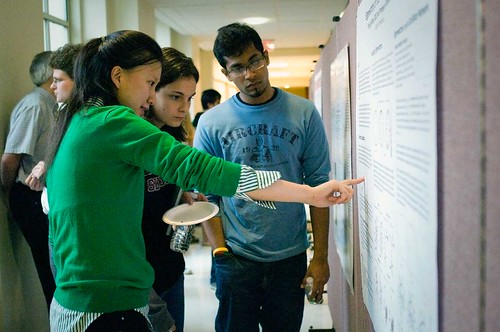Shujing Wang ’12 and Daniel Michev ’14 were both excited and nervous when presenting the results of their summer research projects to a classroom full of students last week.
Michev collaborated on his project, which explored voting methods, with Elizabeth Wilcox, visiting assistant professor of mathematics.
He began his presentation by explaining the concept of voting theory and said that the most common method, the plurality system (a candidate with the most votes wins, even without an absolute majority of votes) is flawed.
Michev came up with his own method that combines two voting systems in order to achieve what he says is maximum fairness. His formula — (W x n/2) + (U x 1/v) — represents a mixture of the method of pair-wise comparisons and the Borda Count, two of the most widely studied voting methods.
His method is not perfect, Michev allowed, but he said with modifications it could potentially improve the effectiveness and fairness of voting.

“I felt like this project was bridging a few different topical areas, economics, voting methods, and math,” said Wilcox, ” which made it very interesting to both of us.”
Wang’s mentor for her project, titled “Eigenvectors of the Network Laplacian,” was Daniel A. Schult, professor of mathematics. Her research focused on how to effectively synchronize networks of oscillators by changing the eigenvalues of the matrix representing that network.
MORE
Each network serves as a representation of the way a “node” is connected via a matrix (the Network Laplacian). Adding or removing edges changes that matrix, increasing or decreasing its eigenvalues (measures of how well oscillators can synchronize).
Giving an example that non-math students could grasp, Wang said, “Imagine each node is a friend you have on Facebook. If you know that person personally, we would draw a line to connect you and that friend. If you don’t know them, though, there would be no line. That is how you create a network.”
Eigenvectors are important topics of study, she said, because of their importance in both pure and applied mathematics.
Both Michev and Wang expressed great enthusiasm for their projects, and both said that while research can be a difficult and, at times, frustrating endeavor, it is very satisfying because of what it uncovers.
“A lot of times you think your method will work, but it doesn’t. Then you just try again and see what you discover,” said Wang.